WHAT IS SOLAR PANEL SYSTEM, HOW DOES SOLAR PANEL SYSTEM WORK , TYPES OF SOLAR PANEL
IS THIS SOLAR PANEL SYSTEM REQUIRED MAINTENANCE?
The use of the highest quality material imparts a sustainable robustness of the respective solar panel system and hence the provided solar panel system need little to maintenance after certain years of installation. What you need is to keep the panels clean and make sure trees do not begin to overshadow them to reap maximum benefit of the sunlight. The effective solution to keep these solar panel systems clean is, tilt them to the certain angle that prevents to accumulate dust, debris and rain water and hence deliver optimal performance.
That connotes there is no any money concerned maintenance is required for effective operation of the installed solar panel systems manufactured by us due to its rugged construction and use of the highest quality material in the construction of the same. What it demands is just frequent checks from time to time to ensure everything is working perfectly. We as a manufacturer of the solar panel system provides regular inspection service, wherein our experts visit your niche and checks the details of the main inverter fault signals and perform key troubleshooting to identify the amount of electricity generating alongside weather conditions that helps to recognize if something going wrong. In short, solar panel systems are absolutely maintenance free; however inverter is likely to demand maintenance or replacement after many years of the installment.
WHAT IS THE HISTORY BEHIND THE INVENTION OF SOLAR PANELS?
Solar energy’s journey kicked off over 100 years ago with folks harnessing sunlight to make steam. Things kicked into gear when Edmond Becquerel hit upon the photovoltaic effect. In 1893, Charles Fritts slapped together the debut solar cell using selenium and a bit of gold.
Then in 1941, Russel Ohl, an American whiz, snagged a patent for the first-ever silicon solar cell clearing the path for Bell Laboratories to whip up the first solar panel in 1954. At the start, space satellites were the cool kids using solar panels, but by the 1970s even pocket calculators got in on the solar action.
Nowadays, solar panels fuel gadgets as tiny as calculators and as huge as whole houses and business places, like the massive Google base in California.
What size solar panel system should I get ?
- It is important you get the right sized panels to meet your household’s needs.
- A single resident and a couple will use about the same amount of energy (3,300kW per year). A family with two children will use between 3,300kW and 4,500kW per year so will need a bigger panel.
- Because of the way the Feed-in tariff works the more energy you produce, the more you get paid. If this is a priority for you, you may wish to invest in a bigger panel.
- This table shows what factors you should consider in a solar panel comparison.
How to calculate size of solar system in India ?
The frequent power cuts that India faces leads to go solar with the off grid system, an off grid solar installation that includes three imperative components, including solar panels, batter and solar PCU, among size of the solar system is a decisive factor for the better output. We as a manufacturer of the solar panel here provide a method to calculate perfect size of the solar panel system:
1. Calculate your total load that you want to run
You need to sum up the load that your electrical appliances consume in order to decide on the size of the solar panel system, like an example, if yours fan, tube light consumes sequentially 35 watts and 75 watts, etc. Correspondingly, you need to add the power consumed by other electronic appliances, for a while assumes that the total is 1000 watts.
2. Size your solar inverter based on electrical load
During the conversion of DC to AC, inverters tend to loss certain amount of energy is a cause for the recommendation of the oversize inverter than the power consumed. For a while we assume that your total power requirement I 1000 watts, hence we counsel for the inverter of the 1600 watts to power the load, which come in 24 voltages.
3. Calculate the total current of your load
- Power (in watts) = Voltage x Current
Now place the determined values in the above equation in order to get total current of your load.
For an e.g. 1000 = 24 Voltage x current
- 1000/24 voltage = current
- 41.66 amps = current
41.66 amps is an amount of current that your solar panel system needs to product in order to operate your entire home or business successfully.
4. Decide how many hours of battery backup you need – buy battery based on that
It is clear that your home or business required 41.66 amps current to run all the electronic appliances, but in conjunction many hours of backup are required. Solar PCU/ inverter connected in the series directly power your electrical load through solar. Nevertheless, when solar is not available, the solar energy accumulated in batteries can be used to power load. For a while, we assume that you need 5 hours of backup. To calculate the size of the batter you required for backing up
Total load (in watts) x hours of backup needed / 24 voltage (inverter)
- 1000 watts x 5 hours / 24 = 208 AH
Go for the batteries having higher amount then 208 AH to get better backup, install two batteries of 150 AH.
- 150 AH + 150 AH = 300 AH
3. Calculate the total current of your load
The reason for evaluating the size of the solar panel at the end of the other selection is because the solar panel going to feed the battery, as well as run electrical appliance directly.
To evaluate the size of the solar panel for batteries:
- Power = voltage x current
Charging Current of Battery = 1/10th of its Total AH.
We have considered 300 AH size of battery, so as 1/10th of the 300 is 30amps.
Hence, charging current of battery = 30 amps
That means your solar panel system must be capable of producing 30 amps to feed battery bank.
In the beginning we have calculated the electrical load that is required to run electronic appliances that was 41 amps.
Simply add the load required + required battery load
- 30+41 = amps.
Our solar panels should make 71 amps.
Make a note that on an average, 250 watts solar panels have a voltage of 30V.
Now again put everything together in the formula that is:
- Power = Volts x Amps
- Power = 30 x 71 amps (load required + required battery load)
- Power = 2130 watts, round it off in 2500 watts
It means you need to install 10 panels of 250 watts each for yielding 2500 watts power to feed your battery band and run electrical load effectively.
Assistance for calculating size of solar panel system:
We as a manufacturer of solar panel provide thorough assistance to calculate the required size for your solar venture, regardless the scale of your solar venture and that is also absolutely FREE OF COST.
Leading Solar Panel System Provider for Sustainable Power
| Area (Sq. Ft.) | Solar Panel Capacity (kW) | Estimated Monthly Output (kWh) | Ideal For |
| 100 – 200 | 1 – 2 kW | 120 – 240 kWh | Small Homes, Cabins |
| 200 – 400 | 3 – 5 kW | 360 – 600 kWh | Apartments, Shops |
| 400 – 800 | 6 – 10 kW | 720 – 1200 kWh | Medium Homes, Offices |
| 800 – 1500 | 11 – 15 kW | 1320 – 1800 kWh | Large Homes, Warehouses |
| 1500 – 3000 | 16 – 25 kW | 1920 – 3000 kWh | Factories, Schools, Hospitals |
| 3000+ | 30+ kW | 3600+ kWh | Industrial Plants, Large Facilities |
Is my roof suitable for solar PV ?
We are well versed to design and manufacture a range of solar panels that are suitable almost all types of roof and hence the answer is yes that our solar panels are suitable for any type of roof, unless your roof is absolutely shadowy or north facing.
How long do solar panel system takes to install ?
We make considerable efforts to complete our order as soon as possible with the highest concentration to complete in a timely manner and hence it just takes a couple of days to install the entire solar panel system, and you will be able to generate electricity the day after your installation is completed.
What is the installation process of solar panel system ?
We as a manufacturer visit your place, inspect and accordingly design a solar panel system, which can be installed just in 2 days once approved by the end of respective embodies.
On getting the permission, we begin the installation work of the solar panel system. At very first, the racking and mounting system are getting installed, which takes a greater amount of time in the entire process is as laborious. After mounting is accomplished, solar panel and inverter can be installed with no extra efforts. Testing of the entire system is carried out by our ingenious team of the engineers and on getting the green signal in regard, one can use it from the moment of testing is positive.
Our job does not finish on completion of the installation, we believe in the permanent relation with the respective clientele by providing after sale service, including inspection and maintenance.
How solar panel system works even on cloudy days
it is very known that solar panel system absorbs sunlight and converts it into the electricity, and hence sun light is indispensable to generate electricity. These solar panels cultivate electricity from the day light not a heat produced by the sun and also during cloudy days in the daytime, thereby it is apparent that solar panels are working even under cloudy days. However, it is actually that these solar panels can yield more electricity in brighter day than cloudy days.
Scientific view on Solar Panel - How does it work ?
The solar panel is a composition of silicon metal, which has a tendency to release electron when light shone onto it, the entire phenomenon known as the photoelectric effect scientifically.
This silicon wafer is treated cautiously to generate electric field, this treated piece of metal is known as solar cells, in which electric conductors are integrated in a way to form a circuit, which seize the released electrons in the form of an electric current and hence you get the output as a current.
The set of such a solar cell is reckoned as photovoltaic modules, and a set of such a photovoltaic module is as photovoltaic panel that produces direct current. As the end current is DC, inverter is attached in series to get AC current.
How does solar cell works ?
The solar cell is a heart of the solar panel system, devised with the highest attention with the help of two types of semiconductors called p-type and n-type silicon, wherein the p-type silicon is manufactured adding up atoms (boron / gallium) having one less electron in their outer orbit than does silicon. The lacking of the electron in the last atom causes hole.
On the other side, n- type silicon is manufactured by adding up atom (phosphorus) having one more electron in their outer orbit than silicon, so as it bonds with its silicon neighbor atoms, however one electron is not in bonding that is free to move inside the silicon structure.
The combination of both p-type and n-type silicon is called solar cells, is a heart of the solar panel system, in which n-type layer has extra electrons, whilst p-type layer has positively charged holes.

Near the junction of the two layers, electrons on the n-type layer move into the holes on the p-type layer and hence it generates an area around the junction called depletion zone, a zone in which which contains negatively charged ions at p-type side and positively charged ions at n-type side. The occurrence of oppositely charged ions forms an internal electric field that prevents electrons in the n-type layer to fill remaining holes in the p-type layer.
This is the actual situation of atoms in the each solar cell of solar panel system. So as now when sunlight strikes a solar cell, electrons in the silicon are ejected and moves to fill holes on the other side. If this happens in the electric field, the field will move electrons to the n-type layer and holes to p-type layer. If you connect both layers with a wire, the electron will move from the n-type layer to p-type layer crossing the depletion zone and thereafter go through the external wire back of the n-type layer, and hence creates a flow of electricity.
Spotlight on the configuration of Solar panel system:
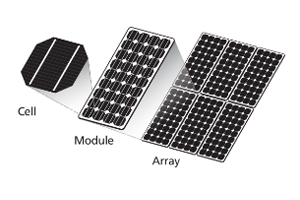
Spotlight on the configuration of Solar panel system:
A solar cell is a small semiconductor device also called PV cell, is capable to convert solar energy into DC electricity through the photovoltaic effect. When light strikes on a solar cell, it may be reflected or absorbed; in which absorbed amount by this solar cell is converted into electricity.
What is solar panel / PV module ?
The solar panel is a collection of solar cells, in which lots of solar cells are interconnected together in a sealed, weatherproof package named panel in order to increase the usefulness of the solar cells. These set of solar cells called solar panels are potent to convert sunlight into electricity with no harm to the environment. This solar panel is also renowned as PV module in the several industries is the synonyms of the solar panel.
Which type of solar panel is best for me ?
There are chiefly three types available in the solar panel, which boast same objective is to convert solar energy into the electricity, they seize energy from the sun and turn it into electricity. However, they differ in the efficacy, cost and performance. In order to make the most of your investment, here we as a manufacturer of the solar panel system have elaborated all three types profoundly.
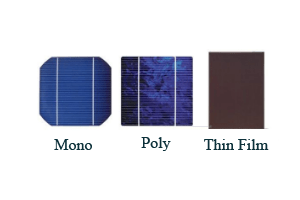
Monocrystalline
As the name implies, this monocrystalline solar panel is made of the single crystal, composed by cutting silicon into wafers. In the construction of this monocrystalline solar panel, free electrons get more room to move and hence are potent to produce a significant amount of electricity with less effort. The uniformity of this single crystalline imparts considerable mechanical, optical and electrical aspects bestows higher strength, higher electrical conductivity which is essential for high performing electrical applications.
This type of monocrystalline solar panel is highly efficient, but quite costlier than polycrystalline solar panels, recommended for large scale solar ventures.
Polycrystalline
The polycrystalline solar panels are also made of the silicon material, despite of using single crystal of silicon, we as a manufacturer of the solar panel have used several fragments of silicon to produce the wafers for the panel. This polycrystalline solar panel is also recognized as multi crystalline or many crystalline silicon. The high number of crystals in each cell provides less room to electrons to move, thus it has lower electricity conducting efficiency than monocrystalline.
These types of solar panels are cheaper alternative to produce electricity, however, have lower efficiency to produce electricity than monocrystalline, recommended for small scale applications.
Thin film
The thin film solar panels are made by putting down layer upon layer of a photovoltaic element, and based on the type of material used, it is mainly available in the four categories, including Amorphous silicon and thin-film silicon, cadmium telluride, copper indium gallium deselenide and dye-sensitized. This type of solar panels is cheaper than other material, but also considerably slow resulted in, very low electricity conducting efficiency.
What is Solar Array ?
When more than one solar panel/ solar module is combined with the single aluminum frame is called solar array. These solar modules or solar arrays are wired in series and parallel orientation to form a PV array to accomplish the desired voltage and current. Typically, 12 V solar panel or solar module will embrace 36 cells connected in series and a 24 V solar panel or solar module will have 72 PV cells connected in series.
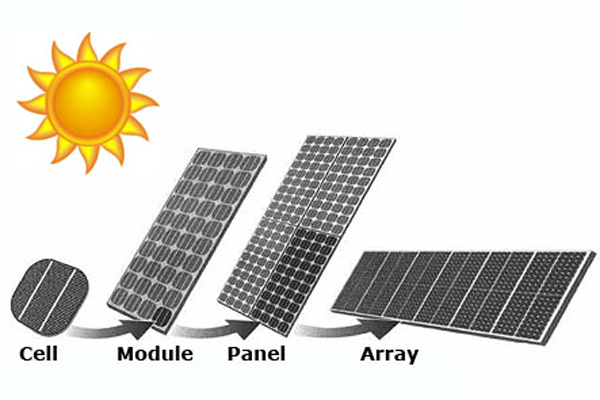
What is solar panel system ?
A solar panel system is a package of inverters, controls, safety disconnects, and batteries. By gathering diverse sizes of components together, we are able to provide a solar panel system of variable power output to meet the need of various loads.
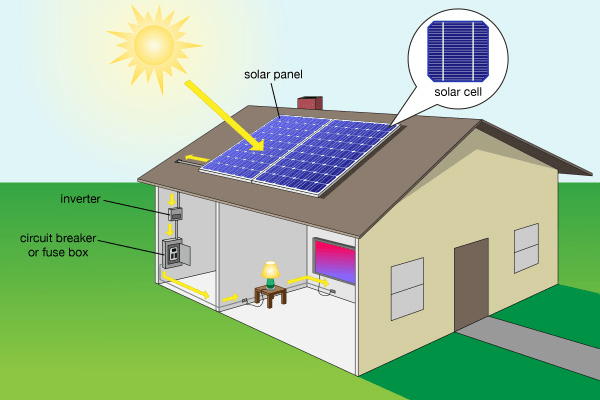
What Are the Types of Solar Panel System ?
The solar panel system provided by us can be classified into mainly three significant types, including standalone, batter backup and grid connected solar panel system. All three types of solar panel systems are configured and manufactured specifically to fulfill all or part of end user’s electrical needs.
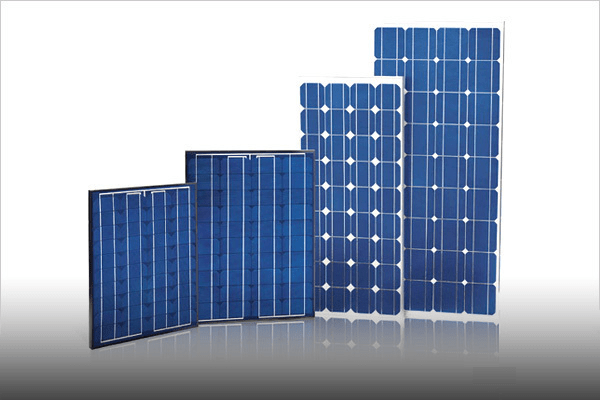
Standalone DC solar panel system
This type of solar panel system generally embraces solar charging modules/panels, storage batteries and control covering a charge regulator. This standalone DC system is an outstanding alternative for generators and lamps in a remote area and recreational vehicle. The size of this solar panel system is wholly depends on the wattage requirement of the respective application.
In this type of solar panel system, typically a PV array charges the battery all through a daylight period and the battery supplies power to the load when required. The charge regulator terminates the charging when the battery reaches full charge.
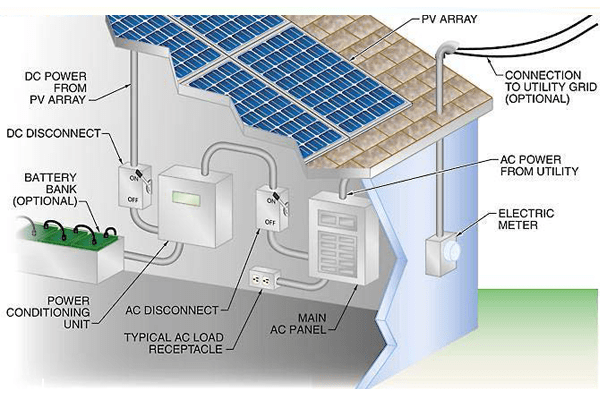
Standalone AC-DC System
The standalone AC-DC solar panel system is quite analogous to the standalone DC system, which covers inverter in addition to charging modules/panels, storage batteries and control covering a charge regulator. This standalone AC-DC system is a most popular type of the solar panel system that works with the same principle and delivers AC power suitable to run household appliances like power tools, vacuum cleaners, washing machines, electronic kitchen appliance, computer and other analogous electronic appliances.
We as a manufacturer of solar panel system provides inverters required converting DC into AC ranging from one hundred watts to ten kilowatts and more, having capability perform exceptionally under any type of weather conditions.
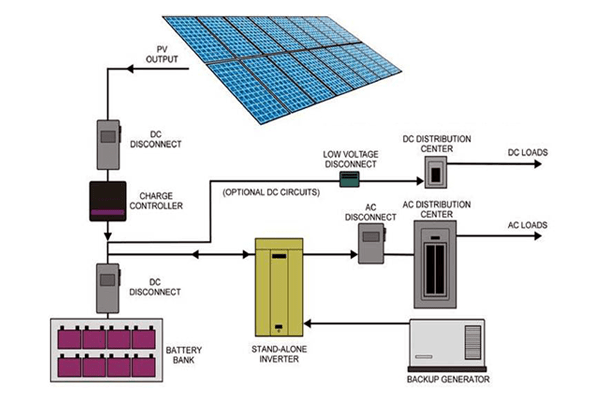
Backup AC Solar Panel System
This backup AC solar panel system has a photovoltaic series of ten or more modules, a battery bank and inverter, wherein the inverter can be one or more as per the requirement of the end user. The system backups the solar and run the loads when available and required. If system power fails due, the power from the battery bank is available to the system.
Utility Interconnected solar panel System (Grid-tied)
This type of solar panel system is immensely known in the market for its simple configuration, which incorporates solar modules, a mounting structure, and AC inverter/control for the power to be fed back through the building’s 120/208/240 volt AC power distribution system. In this configuration, there is no need of batteries as they are designed to contribute power back into the existing power supply not for back-up power.
This type of solar panel system is widely applauded for lowering building’s power bills, as the solar panel system connected to the grid will pay for themselves over many years and decrease the air pollution caused by several companies that burn coal. These interconnected solar panel systems are typically being used to reduce power demands from the net metering, power on in certain cases to sell power back to the utility.
Brief on how solar panel system works ?
- Daylight hits cells of the solar panel system which is converted into the direct current.
- The produced DC current travels feed into the inverter which converts it into AC current.
- The output current from the inverter is just like power supplied by your utility company and can go directly to power all household appliances and lights
- If the battery is connected to the system, an excessive current feed into the battery where it keeps stored to use when sunlight is not available.
Why invest in solar panels ?
Installing solar panel system enables you to save approximately 50% on your electricity bills…! Meanwhile generates clean energy for your home or business.
Solar Installation a sound investment….
It is very manifest from the current situation that electricity going to be sky high price in the future, they might be double in coming ten years. On the other side, Sun provides an enormous amount of solar energy at free of cost, that means solar energy you are collecting from an installed solar panel system on your home or business will still be free of cost.
